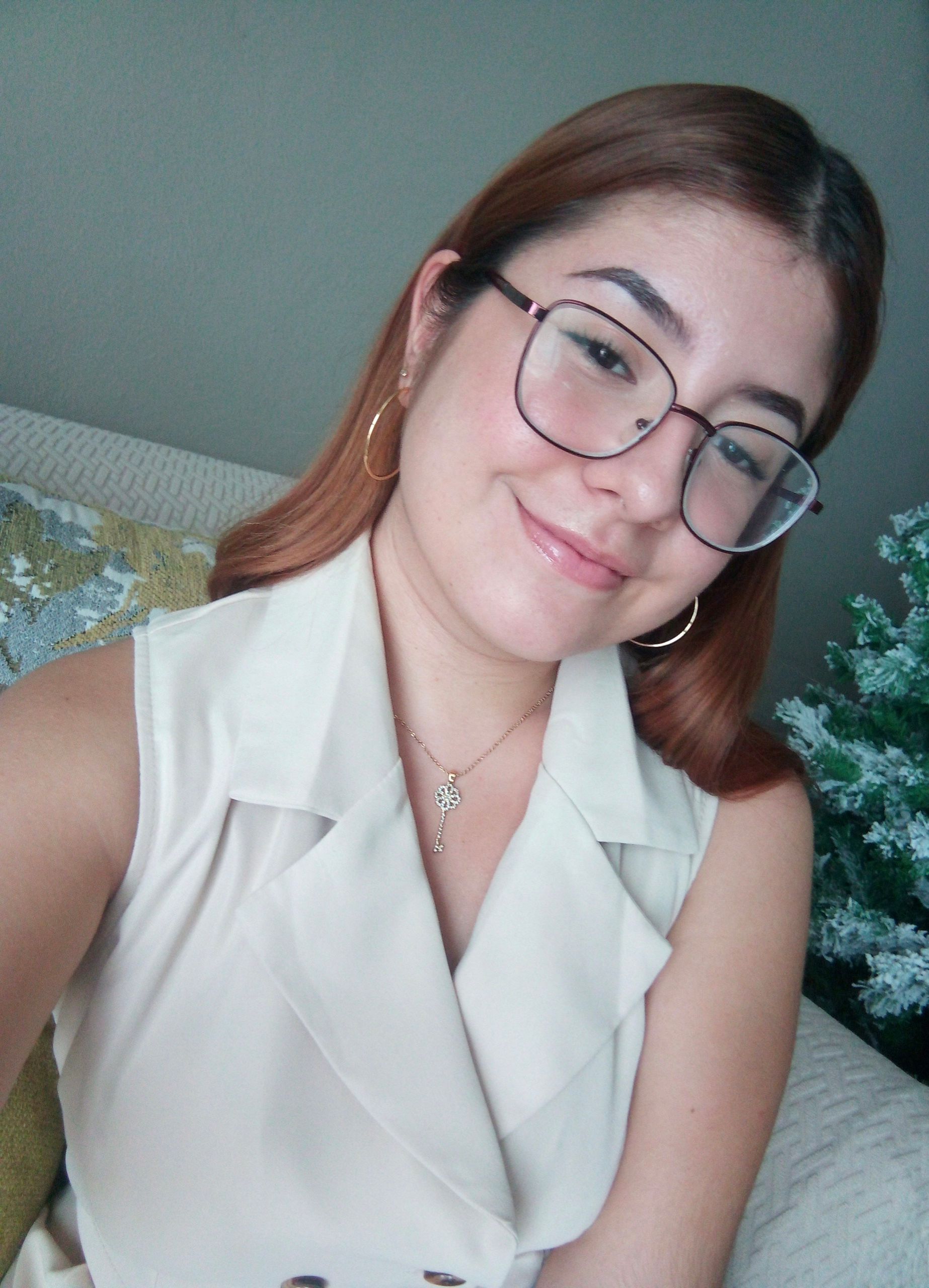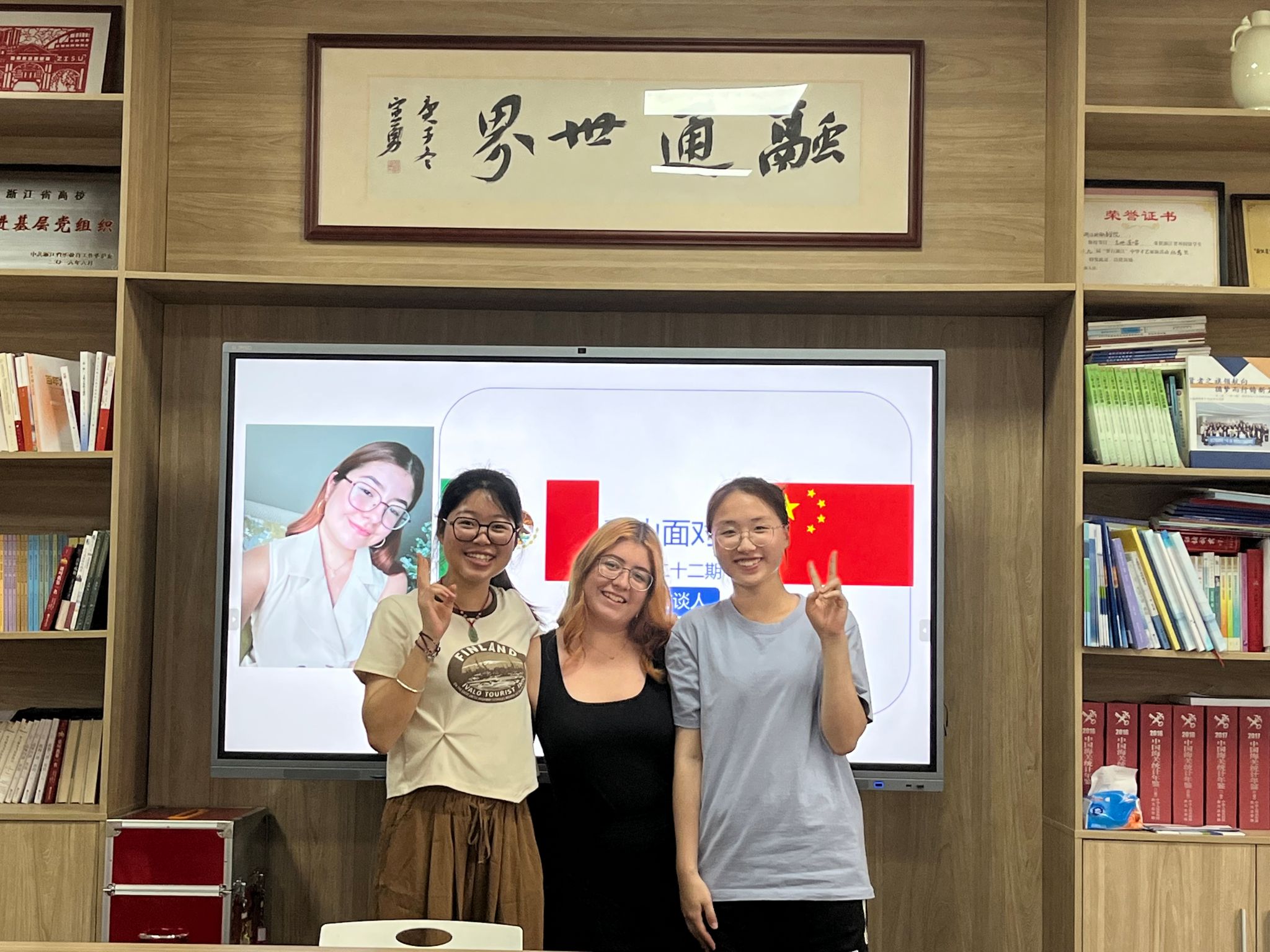为了进一步了解和关心国际留学生在校学习和生活情况、增进对留学生所在的国家文化的认识、培养学生国际视野、促进文化交流和文明沟通,国际学院针对留学生推出了教育开放推广季“跨文化视野”之“和山面对面”系列访谈节目。5月10日下午英语语言文化学院英语师范专业的潘锦同学对安如比进行了访谈。
安如比,来自墨西哥,2024级国际经济与贸易专业的学生。
Santa Ana Meléndez Rubí Esmeralda, from Mexico, who is study International Economics and Trade now.

Q1:如果我想去墨西哥旅游,你会推荐哪些城市?
安如比:1.墨西哥城(Ciudad de México)是我们的首都,也是墨西哥最大的城市,历史古迹,博物馆,宫殿,纪念碑,商场,政府大楼,应有尽有。其中,位于宪法广场的墨西哥国家宫非常气派。2.科利马(Colima)是我生活的城市,有一座海拔四千多米的雪山,从我住的地方就可以看到,如果你去的话可以远足或者爬到火山山顶,景色非常优美。3.坎昆(Cancún)是墨西哥的国际旅游城市,三面环海,有很多海滩,可以在洁白的海岸上享受加勒比的阳光。4.瓦哈卡(Oaxaca)位于墨西哥南部,有很多山脉,比如著名的阿尔万山(Monte Albán),阿尔万山遗址也十分开阔宏伟。漫步于历史街区,还可以欣赏各种精致的建筑和博物馆。5.巴亚尔塔港(Puerto Vallarta)也是一座沿海旅游城市,除了阳光和海滩,夜生活同样丰富。6.瓜达拉哈拉(Guadalajara)是墨西哥第二大城市,建筑风格各异,从巴罗克风格到现代风格都有,城市有上百个宗教特色的建筑,其中最重要的就是瓜达拉哈拉大教堂。
Q1: If I want to travel to Mexico, which cities would you recommend?
Rubí: 1. Mexico City (Ciudad de México) is our capital and the largest city in Mexico, with historical monuments, museums, palaces, monuments, shopping malls, government buildings, and everything else. Among them, the Mexican National Palace located in the Constitution Square is very impressive. 2. Colima is the city where I live, with a snow-capped mountain more than 4,000 meters above sea level. From where I live, I can see it. If you go there, you can hike or climb to the top of the volcano, and the scenery is very beautiful. 3. Cancún is an international tourist city in Mexico, surrounded by the sea on three sides and with many beaches. You can enjoy the Caribbean sunshine on the white coast. 4. Oaxaca is located in southern Mexico and has many mountains, such as the famous Monte Albán. The ruins of Monte Albán are also very magnificent. Strolling through the historic districts, you can also enjoy various exquisite buildings and museums. 5. Puerto Vallarta is also a coastal tourist city, with not only sunshine and beaches, but also wonderful nightlife. 6. Guadalajara is Mexico's second largest city, with different architectural styles ranging from Baroque to modern. The city has hundreds of religious buildings, the most important of which is the Guadalajara Cathedral.
Q2:可以介绍一些特色美食和饮品吗?
安如比:墨西哥有很多美食,辣的甜的,我都非常喜欢。1.首先你可能知道的是Tortilla,用玉米面制成,通常加肉、豆类、生菜和奶酪等,就像中国的米饭,如果有了这个,你可以搭配其他各种东西一起吃。2.有一个甜食是Chiles en Nogada,蒸熟的辣椒中塞满了水果和坚果,然后淋上奶油和石榴籽。它也被认为是墨西哥最爱国的菜肴之一,因为墨西哥国旗的颜色是绿色、红色和白色。3.Tamales 跟中国的粽子很像,不过是用黄色的叶子包住加了肉和豆子的玉米面团,煮熟之后一般会搭配Atole(一种玉米糊汁)一起吃。4.Taco也是墨西哥的传统食物,用玉米粉制作Tortilla,卷成U字型后烤熟,将已熟的肉馅、蔬菜、芝士酱、柠檬汁等配搭一起食用。5.最有名的酒是Tequila(龙舌兰酒),是以一种植物agave为原料所制作成的,味道很不错。6.在我的城市有一种传统的饮料叫Tuba Colima,主要由棕榈汁酿造而成,还可以加入坚果和一些新鲜水果。7.Jamaica是一种花茶,Tamarindo类似于果汁,加入了horchata(巴旦杏仁糖浆),两者都是常见的墨西哥冷饮。8.街头会有很多商贩卖Nieve de Garrafa,一种清淡的刨冰,配有各种糖浆。9. Guacamole是将牛油果捣成泥,加入柠檬、西红柿、洋葱和香菜制成的,与海鲜、烤肉和各种墨西哥小吃完美搭配。
Q2: Can you introduce some special food and drinks?
Rubí: There are many delicious foods in Mexico, spicy and sweet, and I really like them all. 1. First of all, you have to know Tortilla, which is made from corn dough and usually comes with meat, beans, lettuce, and cheese. Just like Chinese rice, if you have this, you can eat it with various other things. 2. There is a sweet food called Chiles en Nogada, steamed chili peppers filled with fruits and nuts, then topped with cream and pomegranate seeds. It is also considered one of Mexico's most patriotic dishes because the colors of the Mexican flag are green, red, and white. 3. Tamales is very similar to Zongzi in China, but we use yellow leaves to wrap corn dough with meat and beans. By the way, it is usually eaten with Atole, a kind of corn paste juice. 4. Taco is also a traditional food in Mexico. Tortilla is made of corn dough, rolled into a U-shaped shape and baked, and cooked meat stuffing, vegetables, cheese sauce, lemon juice, etc. are eaten together. 5. The most famous wine is Tequila, which is made from a plant called agave and has a great taste. 6. In my city, there is a traditional beverage called Tuba Colima, which is mainly brewed from palm juice and can also be mixed with nuts and some fresh fruits. 7. Jamaica is a type of floral tea, Tamarindo is similar to fruit juice and is mixed with horchita (almond syrup), both of which are common Mexican cold drinks. 8. There will be many vendors selling Nieve de Garrafa, kind of ice cream with various syrups. 9. Guacamole is made by mashing avocado into a paste and we also add lemon, tomato, onion, and coriander, perfect for pairing with seafood, grilled meat, and various Mexican snacks.
Q3:通过电影《寻梦环游记》我知道了墨西哥亡灵节,能详细介绍一下吗?或者还有什么别的传统节日?
安如比:1.在墨西哥,亡灵节是一个重要的节日。庆祝活动时间为11月1日和2日,传统的纪念方式为搭建私人祭坛,摆放糖骷髅(Calaverita de Azúcar)、万寿菊(Cempasúchil)和逝者生前喜爱的食物,祭坛上的面包(Pan de Muerto)与平常食用的面包是不同的,不同的形状有不同的含义。这是一个非常多彩的节日,不同于中国,我们觉得不应该伤心,而是要欢乐地迎接与死去亲人的团聚。节日里,无分男女老幼,都可以戴着面具,穿上印着白骨的鬼怪衣服。2.最重要的是独立日,每年的9月16日,庆祝我们不被西班牙殖民,成为一个独立的国家。在前一天的晚上,总统会在总统府阳台上向聚集在宪法广场上的民众发出“独立呐喊”,这是一个传统的庆祝活动。在独立日当天,多地民众会自发组织游行集会,还会穿着色彩鲜艳的传统服饰在广场上载歌载舞。3.在墨西哥,新年的时候,辞旧迎新的钟声会敲响十二下,每敲一下,人们就会吃下一粒“许愿葡萄”,并且许下愿望,总共要吃十二颗葡萄。跟中国一样,我们也是家里人聚餐,然后在一起守岁。
Q3: I have learned about the Mexican Day of the Dead through the movie Coco. Could you tell me more about it? Or are there any other traditional festivals?
Rubí: 1. In Mexico, the Day of the Dead is an important festival. The celebration takes place on November 1st and 2nd, and the traditional way of commemorating it is to build a private altar, placing sugar skulls (Calaverita de Azúcar), marigolds (Cempasúchil), and the deceased's favorite foods. The bread on the altar (Pan de Muerto) is different from the usual bread, with different shapes having different meanings. This is a very colorful festival, different from China, where we feel that we should not be sad, but should joyfully welcome the reunion with our deceased loved ones. During the festival, regardless of gender, age, or sex, people can wear masks and dress in ghost costumes with white bones printed on them. 2. The most important festival is Independence Day, which is celebrated every September 16th to commemorate our independence from Spanish colonial rule. The president will issue a "Shout of Independence" to the people gathered on the Constitution Square on the balcony of the presidential palace the night before, which is a traditional celebration. On Independence Day, people in many places will spontaneously organize parades and gatherings, and will wear colorful traditional costumes to sing and dance in the square. 3. In Mexico, on New Year's Day, the bells will ring twelve times to mark the end of the old year and the beginning of the new. With each ring, people will eat a "wishing grape" and make a wish. A total of twelve grapes will be eaten. Like China, we also have family dinners and stay up all night together.
Q4:听说墨西哥人大多能歌善舞,有什么特色舞蹈和服饰吗?
安如比:墨西哥每个州的传统舞蹈和服饰都不尽相同。比如Ballet Folklórico,衣服有很长的裙摆,也有短的,色彩也是多种多样,还可以搭配簪花造型或者戴各式各样的帽子。
Q4: I heard of that most Mexicans are good at singing and dancing. What are the special dances and costumes?
Rubí: The traditional dances and costumes in each state of Mexico are different. For example, Ballet Folklórico has long skirts and short ones, with a variety of colors. It can also be paired with hairpins or worn with various hats.
Q5:你在墨西哥上的是哪所大学?为什么会选择来我们学校呢?
安如比:我是在科利马大学学习国际经济与贸易,目前大三,学校和ZISU有合作项目,同时我对中国很感兴趣,所以我选择了来交换一学期,学习中文和更多专业知识。
Q5: Which university do you attend in Mexico? Why did you choose to come to our school?
Rubí: I am a junior at the University of Colima, where I am studying International Economics and Trade. There is a collaborative program between my university and ZISU, and I am also very interested in China, so I chose to come for a semester to learn Chinese and gain more professional knowledge.
Q6:你有什么特长吗?
安如比:我擅长画画,基本上画风景,还画过美杜莎,我也擅长跳舞,享受在聚会上跟着拉丁音乐舞动的感觉。
Q6: Do you have any special skills?
Rubí: I am good at painting, mostly landscapes, and have painted Medusa as well. I am also good at dancing, and enjoy the feeling of dancing to Latin music at parties.
Q7:在中国待的两个月期间有什么跟墨西哥不同的体验吗?
安如比:1.在墨西哥,我们对周围的人都很热情,但是在ZISU有个经历我现在还记得,走在校园里跟迎面来的一个陌生同学打招呼,她一脸茫然地看着我,然后什么都没说就走了,我感觉很奇怪,可能她比较害羞吧。2.在墨西哥,住在一个社区的人都非常熟悉,碰到有人打喷嚏会说Salud,希望他们早日康复,身体健康,但中国人之间好像很少会这样。3.在吃饭方面,我们更多习惯用手,但中国人会用筷子、勺子和手套之类的,不让自己的手变脏。4.还有一个很大的不同就是安全,我非常震惊你们这里的人把手机和电脑放在位子上,然后人却不在。墨西哥小偷很多,如果这么做,你的东西一会儿就不见了,不再属于你。我记得我刚到中国,在上海落地,过海关填表的时候把手机落在那里了,我以为找不回来了,再回到原来的地方,发现还在那里,失而复得的感觉真好。另外,在中国手机支付非常方便,不需要带很多现金,也不用担心被偷或者弄丢了。5.我在墨西哥上大学可以住在自己家,非常舒服,但在中国就是住在宿舍里,有点不习惯。
Q7: During your two-month stay in China, did you have any different experiences from Mexico?
Rubí: 1. In Mexico, we are very enthusiastic towards the people around us, but I still remember an experience I had at ZISU. Walking on campus and greeting a stranger who came towards me, she looked at me blankly and then left without saying anything. I felt very strange, maybe she was shy. 2. People living in a community are very familiar with each other, and when they encounter someone sneezing, they will say "Salud" and wish them a speedy recovery and good health. However, it seems that this is rarely done among Chinese people.3. In terms of eating, we are more used to using our hands, but Chinese people use chopsticks, spoons, gloves, etc. to keep their hands clean. 4. Another big difference is safety. I was shocked that people here leave their phones and computers on their seats without staying with them. There are many thieves in Mexico, if you do this, your things will disappear in a short time and no longer belong to you. I remember when I first arrived in China and landed in Shanghai, I left my phone behind when filling out customs forms. I thought I couldn't find it, but when I returned to the original place, I found it still there. It feels great to have something back after losing it. In addition, mobile payment is very convenient in China, without having to carry a lot of cash or worry about being stolen or lost. 5. I can live in my own home while studying in Mexico, which is very comfortable, but living in a dormitory in China is a bit unaccustomed.
Q8:除了杭州,你还去过中国其他城市旅游吗?
安如比:很遗憾没有,但目前有去北京游玩的计划,爬长城,看故宫等等,希望以后有机会去更多地方。
Q8: Apart from Hangzhou, have you traveled to other cities in China?
Rubí: Unfortunately, no. But I have plans to visit Beijing at present, such as climbing the Great Wall and visiting the Forbidden City. I hope to have the opportunity to visit more places in the future.
Q9:你会说几门语言呢?
安如比:我会说流利的西班牙语和英语,目前学了一年半汉语,学了半年法语。
Q9: How many languages can you speak?
Rubí: I can speak Spanish and English fluently. I have been learning Chinese for one and a half years and French for half a year.
Q10:我想要提高自己的西语水平,你可以推荐一些适合学习的剧和电影吗?
安如比:有部电影叫The Book of Life,跟Coco一样,也是讲述的墨西哥亡灵节。还有一部获得过奥斯卡奖的电影Rome,介绍了墨西哥城里一个家庭的故事。再推荐一个演员Eugenio Derbez,他演的喜剧《非常父女档》(No se Aceptan Devoluciones)非常幽默。我想起来小时候我爸爸让我看Ni Hao, Kai-Lan!学习中文,或许你可以反过来学西语。
Q10: I want to improve my Spanish level. Can you recommend some suitable series and movies for learning?
Rubí: There is a movie called The Book of Life, which, like Coco, also tells the story of the Mexican Day of the Dead. There is also an Oscar-winning movie,Rome, which introduces the story of a family in Mexico City. I also want to recommend an actor, Eugenio Derbez, who played in the comedy No se Aceptan Devoluciones, which is very humorous. I remember when I was little, my father put this show, Ni Hao, Kai-Lan! for me to learn Chinese. Maybe you can learn Spanish in the opposite way.
Q11:你未来的计划是什么呢?
安如比:今年暑假我就会回到科利马,完成剩下的学业,我没有比较长远的计划,更专注于当下,不会制定很严格的计划,根据情况调整,毕业后可能会直接找工作,我同样期待再次回到中国!
Q11: What are your future plans?
Rubí: I will return to Colima this summer to complete my remaining studies. I don't have long-term plans, but I am more focused on the present and won't make strict plans, adjusting according to the situation and may directly seek employment after graduation. I also look forward to returning to China again!


